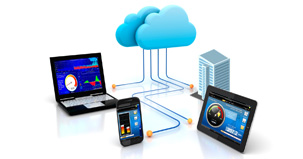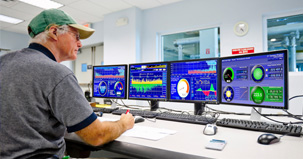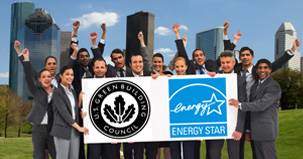- Home
- Smart Data
Smart Data
Actionable intelligence on energy and water use:
- Helps users identify inefficencies, and waste
- Provides real-time feedback on conservation
Right data for the right audience:
- Facility managers identify when and where energy is wasted
- CFO's can track and verify financial savings from initiatives
- Company knows its carbon and water footprint
Related Products
 Information any time, anywhere
Information any time, anywhere - Smart User
Smart User
Smart users leverage real-time data and reduce energy and water use by:
- Continuously identifying opportunities
- Acting on opportunities
- Tracking and verifying savings
- Sustaining savings
Related Products
 Monitor, Manage, Maintain
Monitor, Manage, Maintain - Smart Community
Smart Community
A smart community is one where all stakeholders are engaged in energy and water conservation. A smart community can be achieved by:
- Showing people precisely how much they are using
- Providing real-time feedback on conservation actions
- Effectively communicating efficiency results
Related Products
 Communicate and Conserve
Communicate and Conserve - Smart Grid
Smart Grid
Smart grid, as we define it, is a "green grid", with efficient resource use and the key to a low-carbon future. We help our customers prepare for the smart grid by:
- Engaging users with smart data
- Enabling smart users to increase resource efficiency
- Educating & empowering smart communities
Related Products
 Smart grid and a smarter future
Smart grid and a smarter future - Smart Buildings
Smart Buildings
Smart buildings maximize resource (energy, water, capital) efficiency. These buildings are optimized using energy and water management process with high data visibility which lead to reduced energy and water spending.
- Higher operating income and higher asset values for owners
- Increased productivity for occupants
- Lower carbon footprint for the community
 Resource efficient buildings
Resource efficient buildings
Subtitle!
Recent Posts
Green and Competitive Advantage: The Learning Curve
Companies are constantly looking for a way to obtain competitive advantage in the marketplace. In fact, the more points of advantage, obviously, the merrier. Options may include lowest price point, market-changing widget, halo branding, introduction of a never-before-seen technology or idea and even favorable legislation, tax breaks, entry into a new market and below-average rate for capital.
In fact, this can be traced back to the beginning of capitalism; bigger, better, best – not to mention cheapest – wins the day. However, what is new this time around is that this edge is happening because companies are leveraging green or sustainability as opportunities to transform the business and not to just simply comply with regulations.
An example is outdoor flooring manufacturer Trex. It uses 50 percent recycled plastic and 50 percent reclaimed wood, most of which would have gone into landfills. Thanks to that green production “recipe,” the materials last longer, with less maintenance. Leader of green in the hospitality industry, Marriott attracts more business than competitors because its corporate customers such as ING can share in that glow of corporate social responsibility.
However, Trex and Marriott remain atypical. Too many other companies have been unable to figure out how to reconfigure green mandates into strategic homeruns for their enterprises. Many see going “green” as an expenditure, rather than savings.
That’s because, a study by MIT and Boston Consulting Group found, making that journey from green-is-good or green-is-required to green as source of competitive advantage has a learning curve.
Take the multi-dimensional business edge GE has gained through EcoImagination. That was started in 2005 by Chief Executive Officer Jeffrey Immelt. But it was built on the green platform established by the previous CEO, Jack Welch, through Six Sigma which cut out steps and materials in processes. Otherwise, EcoImagination wouldn’t have made such rapid strides.
Another example is the building industry. It has been getting out there and experimenting with everything from how to apply for a permit and tax credits to what materials to use and how to reduce waste. As a result, the National Apartment Association reports competitive advantages for some of its members who mastered the green game. Those include fast-track permits, Energy Efficient Builder Tax Credits, and lower cost for materials and labor. Consequently, they can provide incentives to renters such as lower utility bills and better quality indoor air. In itself, those lower the cost of filling those apartments.
What is preventing more companies from being able to make progress on the learning curve? According to the MIT-Boston Consulting study, a key obstacle was a reactive mindset. The attitude was that government regulations as well as consumer green concerns demanded compliance. End of story. That defensive approach closed off access to seeing these developments as opportunities for new products and services, processes, pricing, and marketing. This happens primarily because organizations have not taken the time to analyze what sustainability means to their very specific business.
Any understanding begins with what is. Smart companies monitor what kinds of energy are being used, how much of it, and what are the impacts on the environment. Online, up-to-the-minute energy monitoring should be a must-have tool in every company’s going-green toolbox.